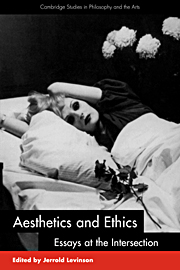Book contents
- Frontmatter
- Contents
- Editor's acknowledgments
- List of contributors
- 1 Introduction: aesthetics and ethics
- 2 Three versions of objectivity: aesthetic, moral, and scientific
- 3 Aesthetic value, moral value, and the ambitions of naturalism
- 4 On consistency in one's personal aesthetics
- 5 Art, narrative, and moral understanding
- 6 Realism of character and the value of fiction
- 7 The ethical criticism of art
- 8 How bad can good art be?
- 9 Beauty and evil: the case of Leni Riefenstahl's Triumph of the Will
- 10 The naked truth
- 11 Aesthetic derogation: hate speech, pornography, and aesthetic contexts
- Bibliography
- Index of names and titles
3 - Aesthetic value, moral value, and the ambitions of naturalism
Published online by Cambridge University Press: 22 March 2010
- Frontmatter
- Contents
- Editor's acknowledgments
- List of contributors
- 1 Introduction: aesthetics and ethics
- 2 Three versions of objectivity: aesthetic, moral, and scientific
- 3 Aesthetic value, moral value, and the ambitions of naturalism
- 4 On consistency in one's personal aesthetics
- 5 Art, narrative, and moral understanding
- 6 Realism of character and the value of fiction
- 7 The ethical criticism of art
- 8 How bad can good art be?
- 9 Beauty and evil: the case of Leni Riefenstahl's Triumph of the Will
- 10 The naked truth
- 11 Aesthetic derogation: hate speech, pornography, and aesthetic contexts
- Bibliography
- Index of names and titles
Summary
Here's a story that Hume, I believe, would have liked.
Someone I know once led a group of U.S. journalists on a tour of Germany. The tour was part of a public relations effort by a German company, so naturally the journalists were prone to be skeptical of what they saw and heard. One of the stops was a sort of clearinghouse where professional tasters made judgments about the quality, readiness, price, and so on of wines from various vineyards and regions. To display their skill to the journalists, the tasters performed blind tests - the journalists would pour wine from numbered bottles into unlabeled cups and then bring them to the tasters, who would attempt to identify the number of the wine. The tasters did so well that one of the journalists thought there must be a trick. He therefore surreptitiously contrived to pour wine from two different bottles into a single cup before submitting it to the tasters. He stood back to watch the reaction. The first taster washed the wine over his tongue, spat it out, and pronounced: “Hmmm… Something's the matter here… maybe you accidentally poured some wine into a cup that wasn't empty? I think I can taste some of number ten, but there's also a bit of something more like number seventeen or… ” After leaving the clearinghouse, the journalist later confessed the trick to his host. “You know,” he said, “those guys are really onto something.”
- Type
- Chapter
- Information
- Aesthetics and EthicsEssays at the Intersection, pp. 59 - 105Publisher: Cambridge University PressPrint publication year: 1998
- 16
- Cited by

